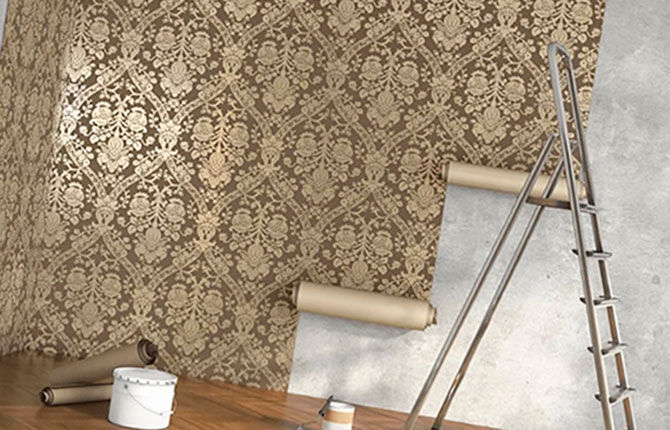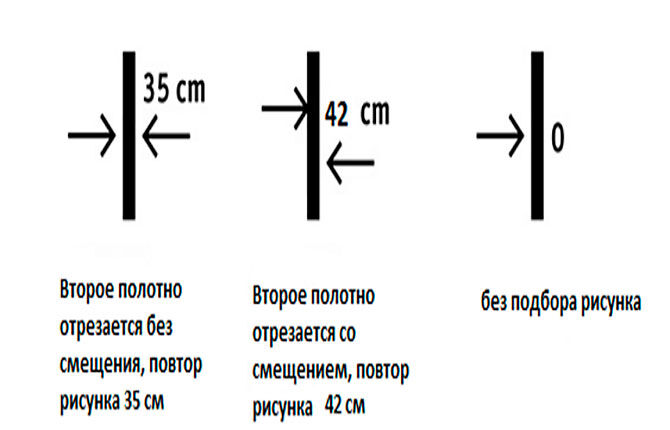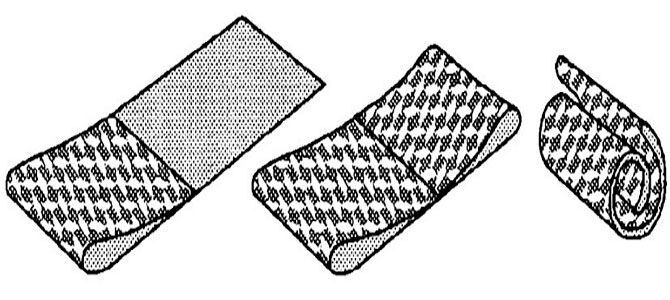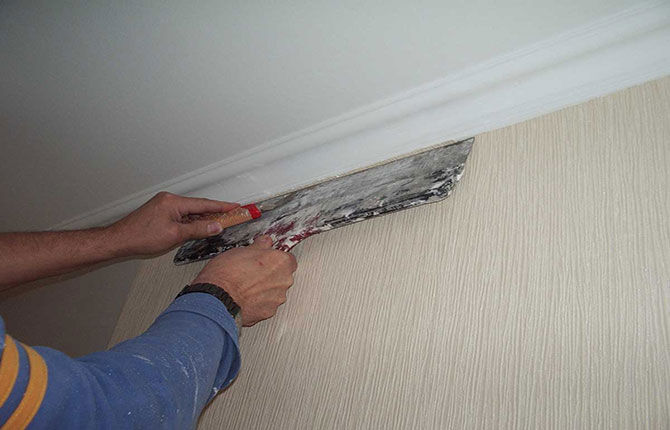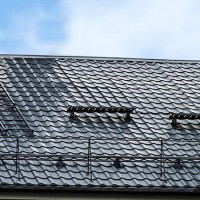How to quickly hang wallpaper alone - tips from professionals
To hang wallpaper alone, you do not need specialized education or repair skills.By following a few simple rules, even a beginner can do the job.
The content of the article:
- Preparatory stage
- How to prepare the surface
- How to do pattern fitting and marking
- How to mark the surface of walls
- How to apply glue and stick canvases
- How to cover areas with sockets and switches
- How to Trim the Excess
- How to cover the area where heating radiators are installed
- Tips from the professionals
Preparatory stage
Before starting work, you need to prepare tools and materials. To hang wallpaper alone, you will need:
- A measuring tool with a scale in millimeters (tape measure or tape).
- Pencil for marking vertical surfaces.
- Level for determining the correct location of the canvases in the vertical plane.
- A knife, stationery or specially designed for cutting wallpaper.
- Paint brush or roller for applying glue.
- Table, sawhorse or ladder. Choose stable structures that can withstand the weight of a person.
- A device for smoothing fabrics (a specialized roller or plastic spatula).
- Glue container.
To prepare the glue, select a container with a wide neck. This makes it easier to mix the mixture. The method and proportions of dilution differ depending on the brand. Before use, study the instructions supplied by the manufacturer.
How to prepare the surface
Before you hang the wallpaper yourself, prepare the walls. At the same time, all large and small irregularities are eliminated. The appearance of the papered walls depends on the quality of the surface.
Preparation is carried out in the following sequence:
- Clean the walls. Remove old paper wallpaper or paintwork.
- Apply priming. Deep penetrating liquids are used. They improve the degree of adhesion of the plaster to the surface. When choosing a composition, pay attention to antifungal properties.
- Cover the uneven areas with a layer of starting plaster. This is a rough composition intended for filling defects of various sizes.
- Apply a layer of finishing putty. This is how small defects are eliminated.
- Sand the finishing putty. For grinding, sandpaper or a specialized mesh is used.
After sanding, a smooth wall is obtained. To remove small abrasive particles and improve adhesive properties, dust generated during grinding is removed with a dry rag.
How to do pattern fitting and marking
To hang wallpaper alone, you should prepare the canvas in advance, taking into account the location of the pattern. This way it is possible to obtain a single canvas in which the individual elements correspond according to the pattern.
For fitting you will need a flat, clean surface. The dimensions of the site depend on the height of the walls. The part of the roll corresponding to the height of the room must be placed on the floor along its entire length.
A piece of the required size is cut from the roll. Lay the canvas on the floor face up. Unwinding the roll, apply it to the first section according to the drawing. After adjustment, cut off the required size piece.
Markings are applied to the segments on the back side. This is how the sequence of gluing the elements is indicated. The marked parts are rolled into small rolls and installed vertically near the wall in order. Thanks to this, a person who decides to hang wallpaper alone will not need to waste time looking for the right piece.
We bring to your attention the article - How to hang wallpaper in corners correctly.
How to mark the surface of walls
To determine how to properly hang wallpaper, markings are applied to the walls. A pencil is used for this. The use of a marker is unacceptable. The lines drawn with a marker will be visible on the surface of the canvas after gluing. The markings are made with slight pressure on the pencil.
A vertical line is drawn on the surface. To check the correct location of the strip, use a building level. To make markings alone, you can use a simple or laser level.
The same distance is measured from the control line in the upper and lower parts. In this case, a distance that is 10-20 mm greater than the width of the roll is retreated from the corner of the room. This way, when gluing, the canvas will not cover the line. This will allow you to control the correct placement of the wallpaper, even if a person is working alone.
How to apply glue and stick canvases
After fitting, marking and marking, they begin to apply glue. It is prepared in a large container. To hang wallpaper alone, for convenience, the composition is collected in small portions into a small container.
To hang wallpaper alone, proceed in the following sequence:
- Cover the floor with a clean cloth. Use cardboard or plastic film. The coating must be larger than the dimensions of the cut elements.
- Place the piece with the back side facing up. To prevent the part from twisting, a weight is placed on the edges.
- Apply a thin layer of glue to the wallpaper. To speed up the process, use a roller. The edges are smeared with a paint brush.
- Fold the strip in half. This is how the adhesive composition saturates the canvas. Afterwards the part is left for 3-4 minutes. Impregnation time depends on the density of the material.
- Holding the strip by the upper part, they climb onto a table, construction trestle or ladder.
- Apply the top of the wallpaper to the wall.
- Level the strip and press it along the entire perimeter. In this case, they follow from the top to the bottom. This is how you can hang wallpaper on your own without any additional support.
- Remove air bubbles. Use a specialized roller or plastic spatula. The joints are additionally smoothed with a roller.
- Remove any excess glue with a clean napkin.
Then they move on to the next strip. By strictly following the sequence of actions, you will be able to hang the wallpaper alone.
We recommend reading! Step-by-step guide on how to glue quickly and easily:
How to cover areas with sockets and switches
Before gluing the strips alone, you should dismantle the electrical wiring elements. To avoid short circuits and injury, the household power supply is de-energized.
Sockets and switches are removed from the installation box. The wiring is disconnected from the working part of the electrical equipment elements. To avoid a short circuit when voltage is applied, the ends of the electrical wiring are insulated. You can use adhesive tape or insulated terminal strips.
After gluing the wallpaper, holes are cut in the locations of the mounting boxes. An even cut is obtained using a stationery knife. The working elements of sockets and switches are connected to electrical wiring and installed in the mounting holes. Irregularities in the cut are covered with decorative parts of switches and sockets.
How to Trim the Excess
Excess parts are cut off after the canvas has dried. If you cut damp wallpaper, the cut area will tear. The excess is cut off with a utility knife.At the same time, its sharpness is controlled. The blade of such a knife is divided into several sections. If the extreme part is dull, it is broken off. The edge of the blade becomes sharp.
To prevent the edge of the wallpaper from tearing when trimming, it is pressed tightly against the wall. To do this, use a flexible ruler or a wide metal spatula.
The part is pressed to the cut site. A knife is drawn along the line of contact. Hold the spatula and remove the excess. This makes it possible to make an even cut.
How to cover the area where heating radiators are installed
One can glue the places behind the radiators in two ways - with dismantling the heating device or without removing the radiator. If you leave the battery in its place, you will need to glue thin strips of wallpaper behind it. It's difficult to do this alone. If dismantling is planned, work is carried out in the following sequence:
- Block the inlet and outlet heating pipelines.
- Unscrew the radiator pipes from the line.
- Drain the remaining liquid into a previously prepared container.
- Dismantle the radiator.
- Wallpaper is glued. In this case, it will be easier to hang wallpaper alone than with a radiator installed.
- Trim off the excess.
- Install and connect the radiator in reverse order.
If wallpapering is carried out during the cold season, you will need to prime the surface with glue before installation. If the radiator temperature is regulated separately from the heating system, the device is not turned on at full power.
Tips from the professionals
For a person who decides to hang wallpaper alone, it is important to follow the sequence of actions. To make it easier to hang wallpaper alone, consider a few tips from professionals:
- When spreading the canvas, glue is carefully applied along the edges.This ensures a reliable connection at the joint.
- When preparing the glue, the composition is gradually mixed until the lumps are completely dissolved.
- During work, keep your hands clean.
- Avoid accumulation of glue on surfaces made of cardboard or film. Failure to comply with this rule will lead to contamination of the canvas.
Taking into account several rules and following the sequence of actions, you will be able to hang wallpaper on your own. To ensure a smooth surface, the walls are puttied and sanded. The absence of unevenness on the vertical surface and uniform application of glue contributes to good adhesion.
Did you hang the wallpaper yourself? What tools did you use? Leave comments and share the article on social networks, add it to bookmarks.
How to quickly and easily hang wallpaper or photo wallpaper on your own can be seen in the video.
